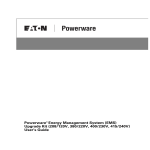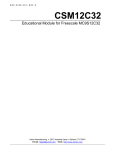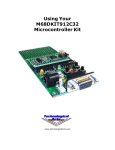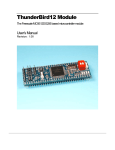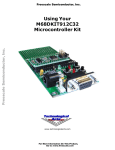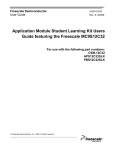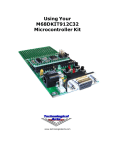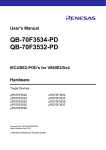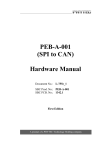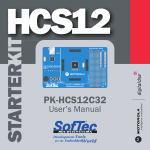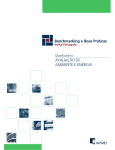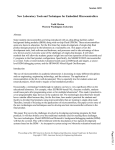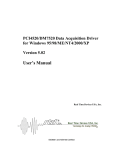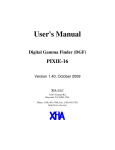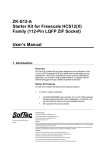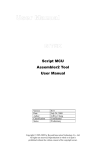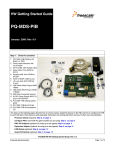Download M68EVB912C32 - Freescale Semiconductor
Transcript
Freescale Semiconductor, Inc. M68EVB912C32 Freescale Semiconductor, Inc... Evaluation Board for Motorola MC9S12C32 ! Axiom Manufacturing • 2813 Industrial Lane • Garland, TX 75041 Email: [email protected] Web: http://www.axman.com ! For More Information On This Product, Go to: www.freescale.com M 6 8 E V B 9 1 2 C 3 2 Freescale Semiconductor, Inc. 0 5 / 1 5 / 0 3 CONTENTS CAUTIONARY NOTES ...........................................................................................................................................................3 TERMINOLOGY ......................................................................................................................................................................3 FEATURES................................................................................................................................................................................4 GETTING STARTED...............................................................................................................................................................5 M68EVB912C32 STARTUP ..................................................................................................................................................5 REFERENCE DOCUMENTATION .................................................................................................................................................6 DEBUG MONITOR OPERATION .........................................................................................................................................6 MONITOR MEMORY MAP: .................................................................................................................................................7 Freescale Semiconductor, Inc... M68EVB912C32 BOARD OPERATION................................................................................................................................7 POWER SUPPLY ...................................................................................................................................................................7 ON_OFF Switch ..................................................................................................................................................................7 PWR - Power Jack ...............................................................................................................................................................8 TB1 - Power Access Term Block..........................................................................................................................................8 VDDR_EN ...........................................................................................................................................................................8 RESET AND RESET CONFIGURATION .....................................................................................................................................8 RESET SWITCH ..................................................................................................................................................................9 LV1 Reset Generator ...........................................................................................................................................................9 LV1_EN Option ...................................................................................................................................................................9 RESET Indicator..................................................................................................................................................................9 MODA and MODB Options.................................................................................................................................................9 MODC Option ...................................................................................................................................................................10 ROM_EN Option ...............................................................................................................................................................10 TEST Option ......................................................................................................................................................................10 OSCILLATOR X1 AND Y1........................................................................................................................................................10 OSC_SEL1 Option – HCS12 clock mode ..........................................................................................................................11 OSC_SEL2 Option .............................................................................................................................................................11 Oscillator Configuration Table .........................................................................................................................................11 COM1 (SCI) PORT .................................................................................................................................................................12 COM1 Connection .............................................................................................................................................................12 RX_EN Option ...................................................................................................................................................................12 RTS_EN and CTS_EN Options..........................................................................................................................................12 CAN PORT .............................................................................................................................................................................13 CAN_TXEN and CAN_RXEN Options ..............................................................................................................................13 RS Test Pad and Cut Option 1...........................................................................................................................................13 RC11,12,and 13 CAN Terminations ..................................................................................................................................14 LED 1-8 INDICATORS AND LED_EN OPTION ........................................................................................................................14 SW1 DIP SWITCH AND SW1_EN OPTION .............................................................................................................................14 OPTIONAL SERIAL EEPROM .................................................................................................................................................14 M68EVB912C32 I/O PORT CONNECTORS ......................................................................................................................15 ANALOG AND PAD0-7 I/O PORT CONNECTOR ....................................................................................................................15 VRH_EN and VRL_EN Options.........................................................................................................................................15 MCU I/O PORT CONNECTOR..................................................................................................................................................16 BDM PORT...........................................................................................................................................................................16 2 On This Product, For More Information Go to: www.freescale.com M 6 8 E V B 9 1 2 C 3 2 Freescale Semiconductor, Inc. 0 5 / 1 5 / 0 3 Cautionary Notes 1) Electrostatic Discharge (ESD) prevention measures should be applied whenever handling this product. ESD damage is not a warranty repair item. 2) Axiom Manufacturing does not assume any liability arising out of the application or use of any product or circuit described herein; neither does it convey any license under patent rights or the rights of others. 3) EMC Information on the M68EVB912C32 board: Freescale Semiconductor, Inc... a) This product as shipped from the factory with associated power supplies and cables, has been tested to meet with requirements of CE and the FCC as a CLASS A product. b) This product is designed and intended for use as a development platform for hardware or software in an educational or professional laboratory. c) In a domestic environment this product may cause radio interference in which case the user may be required to take adequate prevention measures. d) Attaching additional wiring to this product or modifying the products operation from the factory default as shipped may effect its performance and also cause interference with other apparatus in the immediate vicinity. If such interference is detected, suitable mitigating measures should be taken. Terminology This development board applies option selection jumpers. Terminology for application of the option jumpers is as follows: Jumper on, in, or installed = jumper is a plastic shunt that fits across 2 pins and the shunt is installed so that the 2 pins are connected with the shunt. Jumper off, out, or idle = jumper or shunt is installed so that only 1 pin holds the shunt, no 2 pins are connected, or jumper is removed. It is recommended that the jumpers be idled by installing on 1 pin so they will not be lost. This development board applies hardwired option selections for several option jumper selections. This option selection applies a circuit trace between the option pads to complete a default connection. This type connection places an equivalent Jumper Installed type option. The circuit trace between the option pads may be cut with a razor blade or similar type knife to isolate the default connection provided. Applying the default connection again can be performed by installing the option post pins and shunt jumper, or by applying a wire between the option pads. 3 On This Product, For More Information Go to: www.freescale.com M 6 8 E V B 9 1 2 C 3 2 Freescale Semiconductor, Inc. 0 5 / 1 5 / 0 3 FEATURES Freescale Semiconductor, Inc... The M68EVB912C32 is an evaluation or development board for the MC9S12C32 microcontroller. Development of applications is quick and easy with the included DB9 serial cable, sample software tools, examples, and debug monitor. The prototyping area provides space to apply the MCU I/O to your needs. The BDM_PORT is provided for development tool application and is compatible with HCS12 BDM interface cables and software. Features: ♦ MC9S12C32 CPU * 32K Byte Flash * 2K Bytes Ram * 61 I/O lines (80 pins) * 6 PWM Timer channels * 8 I/O Timer Channels * 8 Channel 10 BIT A/D * SPI Serial Port * SCI Serial Port * CAN 2.0 Port * Key Wake-up Ports * BDM DEBUG Port * Clock generator w/ PLL * Up to 25Mhz operation ♦ 8Mhz Clock Oscillator ♦ Regulated +5V power supply ♦ SCI1 Serial Port w/ RS232 DB9-S Connector * SCI1 Serial Port ♦ CAN Port w/ 1M baud transceiver ♦ Power ON/OFF switch ♦ User Components Provided * 8 LED Indicators (PB0-7) * 8 Position DIP Switch (PA0-7) ♦ MCU Port connector provides all digital I/O ♦ Analog Port connector provides analog inputs or PAD0-7 I/O ♦ Large Prototype Area ♦ Optional SPI Serial EEPROM ♦ Supplied with DB9 Serial Cable, Documentation (CD), Manual, and Wall plug type power supply. M68EVB912C32 Specifications: Board Size 5” x 6” Power Input: +6 to +20VDC, 9VDC typical Current Consumption: 40ma @ 9VDC input 4 On This Product, For More Information Go to: www.freescale.com M 6 8 E V B 9 1 2 C 3 2 Freescale Semiconductor, Inc. 0 5 / 1 5 / 0 3 GETTING STARTED Freescale Semiconductor, Inc... The M68EVB912C32 single board computer is a fully assembled, fully functional development board for the Motorola MC9S12C32 microcontroller. Provided with wall plug power supply, support disk, and serial cable. Support software for this development board is provided for Windows 95/98/NT/2000/XP operating systems. Development board users should also be familiar with the hardware and software operation of the target HCS12 device, refer to the provided Motorola User Manual for the device and the HCS12 Reference Manual for details. The EVB board purpose is to promote the features of the 9S12C32 device or to assist the user in quickly developing an application with a known working environment. Users should be familiar with memory mapping, memory types, and embedded software design for the quickest successful application development. Application development may be performed by applying the provided embedded serial interface Debug Monitor, or by applying a compatible HCS12 BDM cable with supporting host software. The debug monitor dedicates the SCI serial port as its connection to the host PC and does not use the traditional background debug mode, thus eliminating the necessity for a background debug mode cable. The Debug Monitor in conjunction with a program running on a host personal computer (PC) provides an effective and low cost debug method. Debug monitor operation enables a user to erase device FLASH memory, program FLASH memory, load application programs, and debug the application programs. Free host software is available for execution on a PC as an interface to the monitor. Debug monitor firmware is provided in the development board HC12 device internal flash memory and applies some HC12 resources for operation. See the Monitor commands application note from Motorola for details and the Debug Monitor chapter in this manual for more information. User applications operated under monitor control may be configured for dedicated operation by applying the User Reset Vector (0xF7FE/F) and programming the application into the device flash. The monitor will remain in protected flash memory for future use if needed. M68EVB912C32 STARTUP 1) Apply power to the EVB board with the provided wall-plug power supply. 2) Install the provided serial cable between the EVB board COM1 port and an available COM port on the host PC. 3) Install monitor hosting software on the host PC and launch. 4) Set the EVB board ON - OFF switch to the ON position and verify the POWER indicator is ON. The EVB is ready to use. 5) Note that if the User Reset vector is programmed, the SW1_EN option jumper must be installed and SW1 position 6 set to the ON position to enable the monitor. 5 On This Product, For More Information Go to: www.freescale.com M 6 8 E V B 9 1 2 C 3 2 Freescale Semiconductor, Inc. 0 5 / 1 5 / 0 3 Reference Documentation Reference documents are provided on the support CD in Acrobat Reader format. Monitor Commands – HCS12 Serial Monitor application note. 9S12C32 manual – 9S12C32 user manuals CPU12RM – HCS12 core user manual with instruction set M68EVB912C32_SCH_C.pdf – M68EVB912C32 board schematics Freescale Semiconductor, Inc... DEBUG MONITOR OPERATION See the Monitor commands application note on the monitor for complete details of operation. Basic operation is provided in this manual. The monitor occupies 2K bytes of flash memory and about to 50 bytes of stack space. It provides a binary command set via the HC12 SCI port and COM1 connection. Monitor operation provides a 24Mhz bus or E clock frequency by default with an 8Mhz reference frequency input. COMMUNICATION: The monitor provides 115.2K baud serial communication on the SCI1 interface port. Monitor applies the SCI Interrupt service in the HC12 device. POWER ON or RESET PROMPT: The monitor will provide a binary prompt to the EVB board serial COM1 port. COMMANDS: No user commands can be applied with a keyboard with software such as HyperTerminal or AxIDE. The monitor commands are binary and not compatible with keyboard (ASCII) entry or display. Host based software should interface with the monitor on the serial communication port to provide development support. INTERRUPT SERVICE SUPPORT: The monitor provides vector relocation in the 9S12C32 flash so user interrupt vectors appear from 0xF780 to 0xF7FF memory space. User will not have access to the SCI, SWI, and RESET vectors while the monitor is operating. Programming the user Reset vector will cause the monitor to execute the user program on Reset. Interrupt and Reset vectors are remapped from 0xFF80 – 0xFFFF to the 0xF780 – 0xF7FF memory range on a one to one basis for user application access. 6 On This Product, For More Information Go to: www.freescale.com M 6 8 E V B 9 1 2 C 3 2 Freescale Semiconductor, Inc. 0 5 / 1 5 / 0 3 Freescale Semiconductor, Inc... MONITOR MEMORY MAP: 0x0000 0x03FF 0x0400 0x37FF 0x3800 0x3FFF 0x4000 0x7FFF 0x8000 0xF77F 0xF780 0xF7FF 0xF800 0xFFFF 9S12C32 Register Space. See the 9S12C32 User Manual for details Not applied on the EVB 9S12C32 Ram space, user application ram Initial Monitor stack = 0x3FFF (reserve 50 bytes) Not applied on the EVB User Application Flash Memory User Interrupt Vectors Monitor Flash Memory Space (Protected) M68EVB912C32 Board Operation The M68EVB912C32 board provides input and output features to assist in application development. These features may be isolated from the applied HCS12 I/O ports by the option jumpers. This allows alternate use of the HCS12 I/O ports for other application and connection on the I/O port connectors. Caution should be observed so that the HCS12 I/O port pin applied to an on board feature is not also applied to external components by the user. POWER SUPPLY Input power is applied by external connection to the J1 power jack or TB1 power access term block. ON_OFF switch operation will enable the +VIN power source from either connection. +VIN is polarity protected by D3 and current limited by FZ1. VR1 provides the main regulated +5V supply and VR2 provides a regulated 2.5V core interface supply applied by the X1 clock oscillator buffer circuits. ON_OFF Switch The ON_OFF slide switch provides board power on and off control. With the switch in the ON position +VIN is applied to the regulator circuits. With +VIN applied and ON_OFF in the ON position, the POWER indicator should be ON. 7 On This Product, For More Information Go to: www.freescale.com M 6 8 E V B 9 1 2 C 3 2 Freescale Semiconductor, Inc. 0 5 / 1 5 / 0 3 PWR - Power Jack PWR provides the default external power input to the board. The PWR jack accepts a standard 2.0 ~ 2.1mm center barrel plug connector (positive voltage center) to provide the +VIN supply of +6 to +20VDC (+9VDC typical). Freescale Semiconductor, Inc... +Volts, 2mm center TB1 - Power Access Term Block TB1 provides access to either apply or tap the +VIN power source to the EVB or to tap the +5V regulated supply for external application. User may apply up to 100ma of +5V to external circuits with a 9VDC +VIN supply. +VIN supply application to user circuits is determined by the +VIN source supply rating or 1 Amp, whichever is greater. TB1 +VIN GND +5V VDDR_EN The VDDR_EN option is hardwired by circuit trace to enable the MC9S12C32 internal 2.5V regulator. The user should not need to modify this connection. RESET and RESET Configuration Operation of the MC9S12C32 during RESET condition allows several options to be configured. These options include Mode of operation, memory configuration, clock source, and development mode selection. The Mode of operation including development modes is defined by the MODA, MODB, and MODC option jumpers. Memory configuration of the internal flash is provided by the ROM_EN option. Refer to the Oscillator X1 and Y1 chapter for clock source configuration. 8 On This Product, For More Information Go to: www.freescale.com Freescale Semiconductor, Inc. 0 5 / 1 5 / 0 3 M 6 8 E V B 9 1 2 C 3 2 RESET SWITCH RESET Switch operation will place the MC9S12C32 in the Reset state. An additional 150 millisecond delay is provided by LV1 after the switch is released. The RESET switch should not be applied with BDM cables connected to the EVB board. The BDM should control RESET generation from the connection on the BDM Port. LV1 Reset Generator Freescale Semiconductor, Inc... Power up Reset is generated by the LV1 voltage detector. The detector will maintain the Reset condition whenever the +5V supply is below 4.5V. The Reset signal is delayed by 150 milliseconds from the correct voltage condition. LV1_EN Option The LV1_EN option is a hardwired by circuit trace enabled option. This option allows the user to isolate the LV1 reset generator and Reset switch from the Reset signal to the MC9S12C32. this option does not need modified by the typical EVB board user. RESET Indicator Reset indicator will light during the active low Reset signal. MODA and MODB Options MODA and MODB jumper options configure the MC9S12C32 in single chip, peripheral, or expanded bus operation at Reset. The M68EVB912C32 board supports the Single-chip mode by default and does not provide the necessary circuits to operate a bus. The user should not need to change the MODA and MODB option from the default positions. Refer to the MC9S12C32 user manual for additional details. MODB MODA GND (Logic low, Default = Single Chip Mode) +5V (Logic high) 9 On This Product, For More Information Go to: www.freescale.com M 6 8 E V B 9 1 2 C 3 2 Freescale Semiconductor, Inc. 0 5 / 1 5 / 0 3 MODC Option MODC jumper option selects Special or Development Mode of operation when in the GND or logic low position. The MODC option jumper must be configured correctly for proper operation of the EVB board and 9S12C32. The option jumper should be in the default Normal mode position at all times unless a BDM cable is attached to the BDM PORT. When a BDM cable is attached to the BDM_PORT the MODC option must be placed in the Special Mode or GND position. MODC Freescale Semiconductor, Inc... GND (Logic low, Special Modes and BDM cable is attached) +5V (Logic high, Default = Normal Modes) ROM_EN Option ROM_EN option is a hardwired by circuit trace option that enables the MC9S12C32 internal flash in all modes. The EVB board does not provide expanded mode operation support circuits so this option should not need modified by the user. TEST Option The TEST option is provided for factory use and should not be modified by the user. Oscillator X1 and Y1 The EVB provides versatile oscillator application with the Y1 crystal circuit or the X1 clock oscillator location. Option jumpers OSC_SEL and OSC_SEL2 select the oscillator source and type for the HCS12 device. The option jumpers allow both types of oscillator source to be installed on the EVB board without conflicts. Default oscillator on the EVB is an 8Mhz clock oscillator installed in the X1 socket. The X1 socket provides for installation of standard half or full size CAN type clock oscillators that operate at 5VDC. A buffer circuit (U3) provided on the EVB limits the X1 output to 2.5Vpp for compatibility with the HCS12 EXTAL input. Crystal location Y1 and associated components C1, C2, R34, and R35 (SMT 1206 size) provide for user application of a crystal oscillator. The user should refer to the HCS12 device user manual for information on frequency selection. The large Y1 component landing pads accommodate several types of surface mount crystal packages however, the surface mount HC49US type is most common. Loading capacitors C1 and C2 should be determined by the crystal specification. R34 provides series loading and R35 provides parallel loading with the crystal. 10 On This Product, For More Information Go to: www.freescale.com Freescale Semiconductor, Inc. 0 5 / 1 5 / 0 3 M 6 8 E V B 9 1 2 C 3 2 OSC_SEL1 Option – HCS12 clock mode OSC_SEL1 provides HCS12 oscillator configuration during device RESET configuration. The option provides the logic value desired for the selected oscillator mode to the HCS12 PE7/XCLKS input during RESET. The OSC_SEL1 option must be configured in conjunction with the OSC_SEL2 option for correct HCS12 operation. See the Oscillator Configuration Table for details. OSC_SEL1 – Crystal Oscillator Mode (Y1 circuit) INTERNAL EXTERNAL Freescale Semiconductor, Inc... OSC_SEL1 – External Clock Mode (X1 source default) INTERNAL EXTERNAL OSC_SEL2 Option OSC_SEL2 provides HCS12 oscillator or clock input selection. The option provides the input source to the device EXTAL input pin. The OSC_SEL2 option must be configured in conjunction with the OSC_SEL1 option for correct HCS12 operation. See the Oscillator Configuration Table for details. OSC_SEL2 – Crystal Oscillator Mode (Y1 circuit) CRYSTAL EXT_CLOCK OSC_SEL2 – External Clock Mode (X1 source) CRYSTAL EXT_CLOCK Oscillator Configuration Table OSCILLATOR SOURCE OSC_SEL1 Setting OSC_SEL2 Setting X1 clock EXTERNAL EXT_CLOCK Y1 crystal INTERNAL CRYSTAL 11 On This Product, For More Information Go to: www.freescale.com M 6 8 E V B 9 1 2 C 3 2 Freescale Semiconductor, Inc. 0 5 / 1 5 / 0 3 COM1 (SCI) Port COM1 is a standard RS-232 compatible serial port controlled by the 9S12C32 SCI port. The RX_EN, CTS_EN, and RTS_EN option jumpers provide HCS12 I/O port connection to the COM1 port on the EVB board. This allows the user to apply the provided communication transceiver or to apply the associated I/O to other purposes. The option jumper positions should be reviewed first if any operational problems are encountered with the COM1 or HCS12 SCI port. Freescale Semiconductor, Inc... COM1 Connection The COM1 port provides standard 9 pin connection with RS232 type interface to the HCS12 SCI peripheral. Refer to the options for enabling the HCS12 signals applied to these ports. The COM1 port is applied by default with the Debug Monitor. The HCS12 SCI module TxD and RxD signals are converted to RS232 levels by U11 and provided to the DB9 serial connectors. Following is the DB9S connection reference. COM1 1 TXD RXD 4 GND 1 2 3 4 5 6 7 8 9 X 6 7 CTS in 8 RTS out 9 Female DB9 connector that interfaces to the HCS12 internal SCI serial port via the U11 RS232 transceiver. 1,4,6 connected Notes: 1) COM1 pins 1, 4, and 6 can be isolated from each other on the bottom of the EVB board under the COM1 connection test pads by cutting the associated test pad circuit trace. 2) COM1 pin 8 (RTS) is pulled to the active flow control enabled level when the RTS_EN option is open. (flow is enabled) 3) Test pad connections are provided for COM1 pins 1-4 and 6-9. The test pads are located behind the COM1 connector on the EVB board. RX_EN Option The RX_EN option jumper will isolate the HCS12 SCI RxD pin (PS0) from the RS-232 transceiver (U11). This allows the HCS12 I/O pin or Transceiver output to be applied to some other user application. Note that this option jumper must be installed for monitor communication. RTS_EN and CTS_EN Options These options allow the user to apply RS-232 serial flow control on the COM1 port. Note that the Monitor communication does not support the flow control operation and that if the user application has configured the RTS output disabled the monitor will not operate. 12 On This Product, For More Information Go to: www.freescale.com M 6 8 E V B 9 1 2 C 3 2 Freescale Semiconductor, Inc. 0 5 / 1 5 / 0 3 RTS_EN The RTS-EN option installed will connect HCS12 I/O port PJ6 (output mode) to the transceiver as the RTS flow control output signal. User application should configure PJ6 as an output and apply a logic low to enable the reception of data from the distant end (PC host normally). A logic high on PJ6 will indicate to the distant end that data should not be sent. User should not apply PJ6 on the MCU_PORT connector if the RTS_EN option is installed. Freescale Semiconductor, Inc... CTS_EN The CTS-EN option installed will connect HCS12 I/O port PJ7 (input mode) to the transceiver as the CTS flow control input signal. User application should configure PJ7 as an input and test for a logic low input before transmitting serial data to the distant end (PC host normally). A logic high input on PJ7 will indicate that the distant end is not ready to receive data and no data should be transmitted. User should use caution not to apply PJ7 on the MCU_PORT connector if the CTS operation is applied or to configure PJ7 as an output with the CTS_EN option installed. CAN Port The CAN PORT provides a 1M baud CAN network transceiver (U12) with CAN_TXEN and CAN_RXEN options to connect the 9S12C32 CAN signals to the transceiver. Termination and bias component locations RC11, RC12, and RC13 are also provided on the CAN_PORT. The CAN_PORT is a 4 position .1 inch space header pin connector with .025sq. pins. See the MC9S12C32 User Manual for information on operating the device CAN peripheral. CAN_PORT 1 = GND 2 = CAN-HI signal 3 = CAN-LO signal 4 = +5V CAN_TXEN and CAN_RXEN Options The CAN_TXEN and CAN_RXEN options connect the HCS12 ports PM1/TXCAN and PM0/RXCAN respectfully to the CAN transceiver (U12). User should open these option jumpers to apply the PM0 and PM1 I/O ports on the MCU_PORT for other applications. RS Test Pad and Cut Option 1 CAN Transceiver U12 is enabled at all times by the default connection to ground provided by Cut Option 1. The user may cut the Cut Option 1 to isolate the ground connection from the transceiver and apply an HCS12 I/O port output to the RS Test pad to control the CAN transceiver. Cut Option 1 is located on the bottom of the EVB board under the CAN_PORT. Operation of the RS Test Pad with a HCS12 port output would be logic low to enable the transceiver and logic high to disable the transceiver. 13 On This Product, For More Information Go to: www.freescale.com M 6 8 E V B 9 1 2 C 3 2 Freescale Semiconductor, Inc. 0 5 / 1 5 / 0 3 RC11,12,and 13 CAN Terminations RC11, RC12, and RC13 provide SMT 1206 size component locations to apply CAN network termination and bias. The values of these components should be determined by the media type and CAN network requirements. RC12 = Termination, connected between CAN-HI and CAN-LO. RC11 = BIAS, CAN-HI idle bias to ground potential. Freescale Semiconductor, Inc... RC13 = BIAS, CAN-LO idle bias to +5V potential. LED 1-8 Indicators and LED_EN Option LED Indicators 1–8 are provided for user application and reflect HCS12 I/O ports PTB0 – PTB7 logic value respectfully when the LED_EN option is installed. PTB0 – PTB7 are buffered from the LED indicators by U5. The LED indicators will light with a logic high signal applied from the respective HCS12 I/O port. The user may apply the PTB signals as inputs or outputs. PTB outputs will allow the user application to control LED indication with a logic high output. PTB inputs will provide a logic input status indication and should be driven from external circuits connected on the MCU_PORT. SW1 DIP Switch and SW1_EN Option With SW1_EN option installed the SW1 positions 1 – 8 provide input to HCS12 ports PTA0 – PTA7 respectfully. The user should apply caution that the PTA0-7 ports are configured to be inputs at all times when the SW1_EN option is installed. The SW1 positions provide a logic low input when in the OFF position and a logic high input when in the ON position. SW1 position 6 also provides the EVB Monitor selection during Reset or power on condition. (Refer to M68EVB912C32 STARTUP). Optional Serial EEPROM The U4 socket and JP1-4 Options provide for the optional installation and connection of an industry standard SPI type Serial EEPROM device. The standard device referred to for installation in the EVB is the ATMEL AT25010 or larger capacity device. The JP1-4 option s will complete the HCS12 SPI port to EEPROM connections if installed. Refer to the M68EVB912C32 schematic drawing for more detail. 14 On This Product, For More Information Go to: www.freescale.com M 6 8 E V B 9 1 2 C 3 2 Freescale Semiconductor, Inc. 0 5 / 1 5 / 0 3 M68EVB912C32 I/O PORT CONNECTORS ANALOG and PAD0-7 I/O Port Connector This port connector provides access to the PAD I/O or Analog input signals. Freescale Semiconductor, Inc... VRL 10 9 PAD7/AN7/ETRIG 8 7 PAD5/AN5 6 5 PAD3/AN3 4 3 PAD1/AN1 2 1 VRH PAD6/AN6 PAD4/AN4 PAD2/AN2 PAD0/AN0 VRH_EN and VRL_EN Options These options are hard wired by circuit trace on the EVB board to default potentials. The user may isolate the default connections by cutting the circuit trace between the option pads on the top of the EVB board. Application of alternate potentials can then be applied at the Analog Port location for the respective signal. 15 On This Product, For More Information Go to: www.freescale.com M 6 8 E V B 9 1 2 C 3 2 Freescale Semiconductor, Inc. 0 5 / 1 5 / 0 3 MCU I/O Port Connector Freescale Semiconductor, Inc... This port connector provides access to all the MC9S12C32 I/O ports except PAD analog port. The signals in brackets are EVB alternate application signals. GND PT7 PT5 PT3 PT1 PP7 PP5 PP3 PP1 GND (CTS) PJ7/KWJ7 PM5/SCK PM3/SS* PM1/TXCAN PS3 PS1/TXD PE7/XCLKS* PE5/MODA PE3/LSTRB* PE1/IRQ* GND (SW1-8) PA7 (SW1-6) PA5 (SW1-4) PA3 (SW1-2) PA1 (LED8) PB7 (LED6) PB5 (LED4) PB3 (LED2) PB1 GND 60 58 56 54 52 50 48 46 44 42 40 38 36 34 32 30 28 26 24 22 20 18 16 14 12 10 8 6 4 2 59 57 55 53 51 49 47 45 43 41 39 37 35 33 31 29 27 25 23 21 19 17 15 13 11 9 7 5 3 1 +5V PT6 PT4 PT2 PT0 PP6 PP4 PP2 PP0 +5V PJ6/KWJ6 (RTS) PM4/MOSI PM2/MISO PM0/RXCAN PS2 PS0/RXD PE6/MODB PE4/ECLK PE2/RW* PE0/ XIRQ* +5V PA6 (SW1-7) PA4 (SW1-5) PA2 (SW1-3) PA0 (SW1-1) PB6 (LED7) PB4 (LED5) PB2 (LED3) PB0 (LED1) +5V BDM PORT The BDM port is a 6 pin header compatible with a Motorola Background Debug Mode (BDM) Pod. This allows the connection of a background debugger for software development, programming and debugging in real-time without using HCS12 I/O resources. Note that the MODC option jumper must be correctly configured to apply a BDM cable. BGND 1 2 GND 3 4 RESET* 5 6 +5V See the HCS12 User Manual for complete documentation of the BDM. 16 On This Product, For More Information Go to: www.freescale.com


















